#kamptozoa
Text
Phylum #22: Entoprocta, the goblet worms!

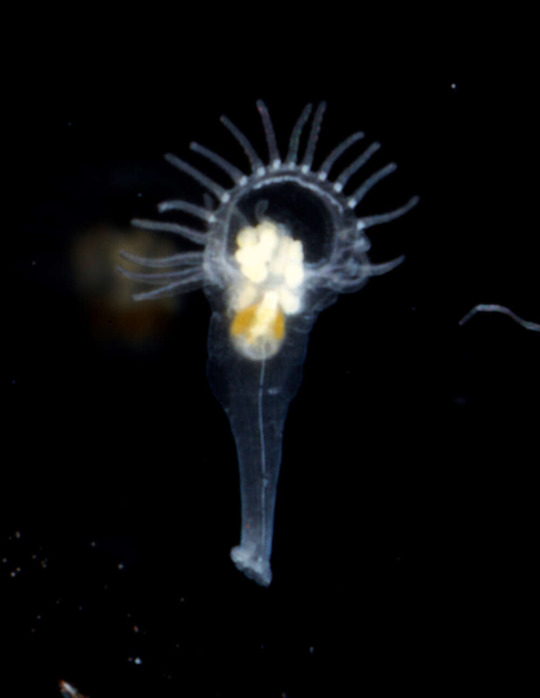
Despite their looks, these are not sea anemones, crinoids or bryozoans - these creatures have in fact been found to be mollusks' closest relatives! Although this part of the tree of life is in flux, entoproctan larva share the peculiar nervous system of mollusks, leading researchers to unite both in a single clade!
Entoproctans or kamptozoans, often referred to as goblets due to their stalked cup-like form, have a much simpler body plan than their relatives. A crown of tentacles at the top of the cup beats to bring a current through the U-shaped gut inside, passively filtering food particles. And that's it!
Goblets often live in massive colonies, with new ones budding from the stalks of previously-established ones. These stalks actually serve a triple function, also extending the reach and allowing them to share nutrients. However, a few species are free-living and solitary, crawling with their foot (their equivalent of the stalk), hitching a ride on other animals, or even jumping over!
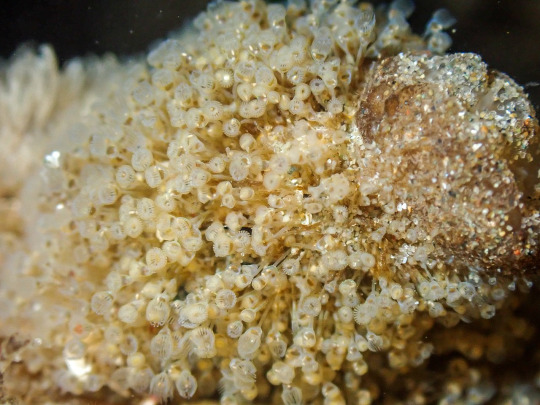
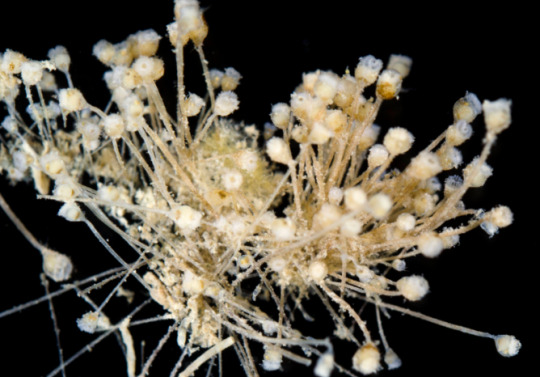
#forms and phyla#entoprocta#kamptozoa#goblet worms#goblets#tetraneuralia#marine biology#marine life#and this tag will make sense much later#bryozoa
81 notes
·
View notes
Text
Phylum Round 1

Chordata: All animals with a backbone (Vertebrata), but also some invertebrates. Chordata includes fish, birds, mammals, reptiles, and amphibians, but also sea squirts and lancelets. All Chordates have a notochord (supportive rod-like structure), a hollow dorsal nerve cord, pharyngeal slits (for filter feeding/breathing), a post-anal tail, and an endostyle (feeding organ) or thyroid (hormonal gland). Interestingly, many Chordates have overcome the need to raise their young in water by laying shelled eggs or carrying young within the womb. Fur, feathers, and scales are all unique adaptations found within Chordata. This phylum exhibits remarkable diversity overall.
Entoprocta (Kamptozoa): Goblet Worms or Nodding Animals. These small cup-shaped animals filter feed using the ciliated tentacles surrounding the "rim". Their most distinctive feature is their "nodding" behavior on their long thin stalk. They can live in marine, brackish, or rarely freshwater habitats. While they closely resemble Bryozoans, they differ in that their anus is located inside the ring of tentacles, rather than outside. Some Entoprocts can live on top of other organisms, taking advantage of the mobility and food-bearing water currents.
#hydrogen bomb vs coughing baby#did I add my own cat as a chordate? Yes. is she a perfect example of a mammal? Also Yes if you don't count the fact that she's missing a leg#chordata#entoprocta#animal bracket#tumblr bracket#bracket tournament#poll bracket#phylum round 1#phylum
115 notes
·
View notes
Text
Transcriptomic data reveals the evolutionary relationships of two groups of ancient invertebrates
Transcriptomic data reveals the evolutionary relationships of two groups of ancient invertebrates
Kamptozoa and Bryozoa are two phyla of small aquatic invertebrates. They are related to snails and clams (collectively called mollusks), bristleworms, earthworms, and leeches (collectively called annelids), and ribbon worms (nemertea). But their precise position on the tree of life, and how closely related they are to these other animals, has always puzzled evolutionary biologists. Previous…
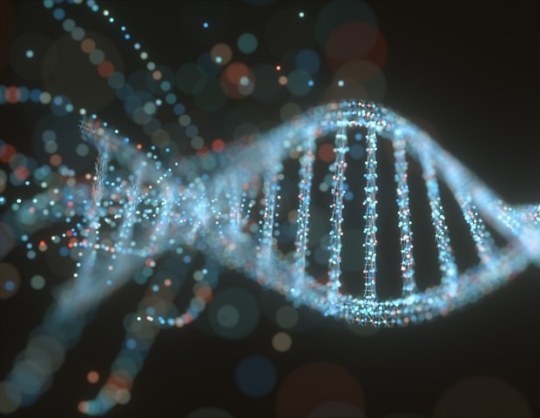
View On WordPress
0 notes
Text
The evolutionary relationships of two groups of ancient invertebrates revealed -- LiveScience.Tech

Kamptozoa and Bryozoa are two phyla of small aquatic invertebrates. They are related to snails and clams (collectively called mollusks), bristleworms, earthworms, and leeches (collectively called annelids), and ribbon worms (nemertea). But their precise position on the tree of life, and how closely related they are to these other animals, has always puzzled evolutionary biologists. Previous studies have consistently moved them around. What’s more, while Kamptozoa and Bryozoa were originally considered to form one group, they were separated based on their appearance and anatomy. Now, by using cutting-edge sequencing technology and powerful computational analysis, scientists from the Okinawa Institute of Science and Technology Graduate University (OIST), in collaboration with colleagues from St-Petersburg University and Tsukuba University, have revealed that the two phyla split from mollusks and worms earlier than previous studies have suggested, and thus they indeed form a distinct group.
“We’ve shown that by using high quality transcriptomic data we can answer a long-standing question to the best of our current techniques,” said Dr. Konstantin Khalturin, Staff Scientist in OIST’s Marine Genomics Unit and first author of the paper published in Science Advances.
A genome is the full set of genetic information found in every cell. It is subdivided into genes. These genes are made up of DNA base pairs and each gene contains the instructions needed to create a protein, and thus leads to the proper care and maintenance of a cell. For the instructions to be carried out, the DNA must first be transcribed into RNA. A transcriptome is the result of this, like the reflection of a genome but written in RNA base pairs rather than DNA.
This genetic information differs among species. Those who are closely related have very similar genetic information, while a greater evolutionary distance results in more genetic differences. By using this data, researchers have improved our knowledge of animal evolution, but some questions still prove difficult to answer.
As Kamptozoa and Bryozoa are closely related to mollusks, annelids, and nemertea, small mistakes in the dataset, or missing data, can result in an incorrect placement on the evolutionary tree. Furthermore, while collecting these tiny animals, it’s easy to pick up other organisms, such as algae, that contaminate the sample. Dr. Khalturin highlighted that they were careful to avoid contamination and later screened their dataset for RNA of algae and small animals to remove any that might have come from them.
In total, the researchers sequenced the transcriptome of four species of Kamptozoa and two species of Bryozoa, but to a far higher quality level than had previously been achieved. While past datasets had completeness of 20-60%, in this study, the transcriptome completeness was over 96%.
Using these transcriptomes, they predicted proteins and compared them to similar data of 31 other species, some of which were closely related to Kamptozoa and Bryozoa, such as clams and bristleworms, and others which were more distant, such as frogs, starfish, insects, and jellyfish. The high-quality datasets meant that they could compare many different genes and proteins simultaneously. Dr. Khalturin credited the powerful computational capabilities that the researchers could access at OIST.
“Our main finding is that the two phyla belong together,” said Dr. Khalturin. “This result was originally proposed in the 19th century by biologists who were grouping animals based on what they looked like.”
While Dr. Khalturin stated that this question had now been answered to the best ability available, he also highlighted that the dataset could answer other fundamental evolutionary questions — such as the more precise location of mollusks and annelids on the tree of life, and how life diversified.
New post published on: https://livescience.tech/2022/07/03/the-evolutionary-relationships-of-two-groups-of-ancient-invertebrates-revealed-livescience-tech/
0 notes
Text
0 notes
Photo

[Technically, the term Bryozoa refers to a clade that includes Ectoprocta and Entoprocta (or Kamptozoa). The terms Ectoprocta and Bryozoa are equated here because one would rather be a bryozologist than an ectoproctologist!] From Halanych (2004)
271 notes
·
View notes
Photo
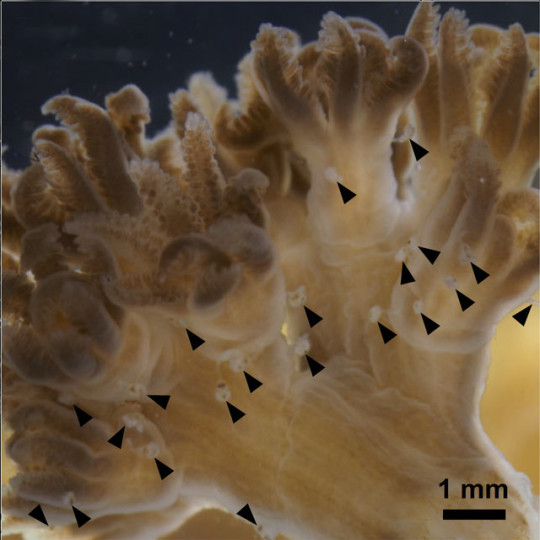
Goblet Worms, A Bizarre New Coral Symbiont - https://reefs.com/2017/07/28/goblet-worms-bizarre-new-coral-symbiont/
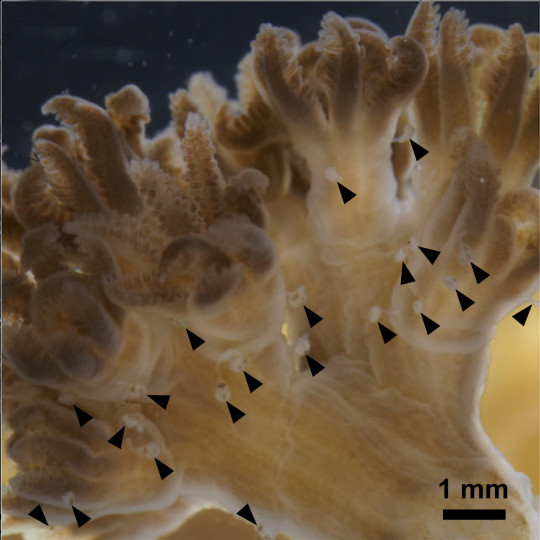
0 notes
Text
Fwd: Job: NHM_UOslo.MarineInvertebrateEvolution
Begin forwarded message: > From: [email protected] > Subject: Job: NHM_UOslo.MarineInvertebrateEvolution > Date: 7 November 2020 at 08:07:05 GMT > To: [email protected] > > > Principal Engineer in ArtsDatabanken project > > About the position > A part-time position as Principal Engineer (80%) is available at the > Natural History Museum (NHM), University of Oslo for two years. The > expected starting date is 01.04.2021. > > The Prinicipal Engineer will be part of the recently founded > ArtsDatabanken-project "Assessing biodiversity in the marine algae > belt". The marine algae belt comprising kelp forests, seagrass meadows > and rocky reefs with coralline red seaweeds is one of the most active > primary producing environments in the sea. It also harbors are great > diversity of animals including sea squirts, ribbon worms, nick worms, > serpulid worms, spionid worms and ghost shrimps. The species of these > groups occupy important ecological functions as herbivores, predators and > filter-feeding organisms and can be sessile or agile as well as solitary > or colonial. Globally these taxa comprise more than 7,000 species with > around 250 species documented from Norwegian waters. Despite this the > knowledge about their taxonomy and distribution in Norway is at best > poor and in dire need of improvement. Specimens in museum collections are > often quite old material, which additionally is often wrongly determined > due to unresolved taxonomic issues including the high degree of cryptic > species in these groups. Besides cryptic species, many of these taxa > include invasive species causing among others high economic damage in > aquaculture and ship transportation due to biofouling. This is why we > will conduct a field inventory in this habitat and collect species of > these taxa in Norway (from the Skagerrak up to 70°N). With morphological > and molecular methods, we will determine the species and learn more > about their distribution (including reports from history and now) and > their association with Norwegian nature types. Therefore, we also want to > revise the existing museum collections in Norway. Through the project, > we will contribute to basic biosystematics and species distribution > research in general, and more specifically and importantly to red > lists or other nature conservation management actions (e.g. updated > information on distributions of invasive and native species including > cryptic ones and their preferred habitats). The Natural History Museum > has a modern DNA laboratory as well as microscopic infrastructure needed > for the project. The position will be associated with the research > group "Frontiers in Evolutionary Zoology", specifically Torsten Struck > (Professor of Evolutionary Genomics). > > Work tasks > - Sorting and identifying specimens from the different habitats to the > required taxonomic level > - Photographic documentation of the species > - Cataloguing and curating the species for the scientific collections > - Determination of molecular barcodes for the different species > - Compilation of research results into reports and publications > - Field sampling (by boat, snorkeling, diving) > > Qualification requirements > - Applicants must hold at least a Bachelor's degree or equivalent > in biology. > - We seek a person with strong motivation for research in marine > invertebrates. > - The candidate must be skilled in sorting, identifying and curating of > invertebrates, preferably marine ones. > - Experience with molecular-biological methods is preferable. > - Taxonomic knowledge in one the projects groups (i.e., Tunicata, > Nemertea, Kamptozoa, Serpulidae, Spionidae or Caprellidae), possession > of a diving licence and/or work experience in a museum is > advantageous. > - Communication skills (including written and spoken English) > > We offer > salary NOK 416 400 - 482 200 per annum in full time position (100%) > depending on qualifications in a position as Principal Engineer (position > code 1085) A friendly working environment, which is close to both the city > center of Oslo, a vibrant and international city, which )is nice to live > in, and to nature parks and mountains Full funding of the project-related > activities, including molecular lab work and participation on field > trips Training in the different animal groups including stays with our > international cooperation partners Flexibility with the arrangement of > the working hours Membership in the Norwegian Public Service Pension > Fund Attractive welfare benefits > > How to apply > - The application must include: > - cover letter statement of motivation > - CV (summarizing education, positions and academic work) > - copies of educational certificates (academic transcripts only) > - list of reference persons: 2-3 references (name, relation to > candidate, e-mail and phone number) > - The application with attachments must be > delivered in our recruiting system. (see here > https://ift.tt/2GB344Y) > > Formal regulations > According to the Norwegian Freedom of Information Act (Offentleglova) > information about the applicant may be included in the public applicant > list, also in cases where the applicant has requested non-disclosure. > The University of Oslo has an agreement for all employees, aiming to > secure rights to research results etc. > > Contact information > Professor Torsten Struck, phone number:+47 22851740, e-mail: > [email protected] > > About the University of Oslo > The University of Oslo is Norway's oldest and highest ranked educational > and research institution, with 28 000 students and 7000 employees. > With its broad range of academic disciplines and internationally > recognised research communities, UiO is an important contributor > to society. The Natural History Museum at the University of Oslo is > Norway's most comprehensive natural history collection. For almost 200 > years, specimens of animals, fungi, plants, rocks, minerals and fossils > have been collected, studied and preserved here. The museum is located at > Űkern and in the beautiful Botanical Garden, which is not only popular > for recreation, but is a scientific collection in itself. > > Jobbnorge ID: 195709, Deadline: 22.11.2020 > > Torsten Hugo Struck >
via IFTTT
0 notes